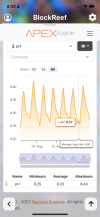Prestondeeply
Guest
I just started measuring pH in the 3 wide nano tanks. These all have their own systems. No water mixing.
pH sits between 7.8 and 8.0 in all 3 tanks. I've been dosing Kalk and alk at various levels in the tanks.
From everything I've read, I should be seeing swings and I don't. At least not enough to distinguish between randomness. Kalk is dosed every 20 minutes and alk every 2 hours offset from kalk, but only during the day.
So, the only thing I can think of is aeration. I use reefglass nano skimmers. Is that enough to keep the pH stable on a 10-20g nano tank?
Or am I missing something?
-Andrew
pH sits between 7.8 and 8.0 in all 3 tanks. I've been dosing Kalk and alk at various levels in the tanks.
From everything I've read, I should be seeing swings and I don't. At least not enough to distinguish between randomness. Kalk is dosed every 20 minutes and alk every 2 hours offset from kalk, but only during the day.
So, the only thing I can think of is aeration. I use reefglass nano skimmers. Is that enough to keep the pH stable on a 10-20g nano tank?
Or am I missing something?
-Andrew


